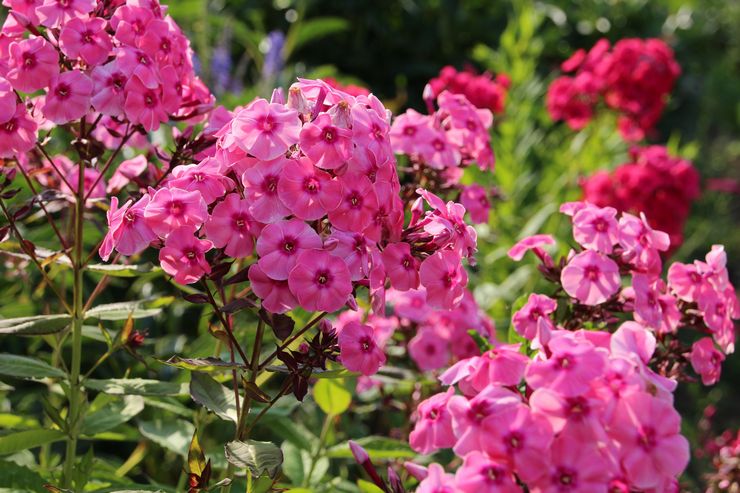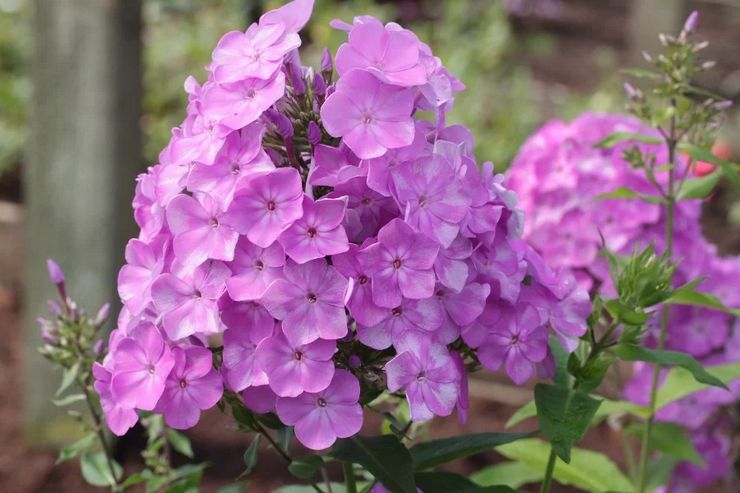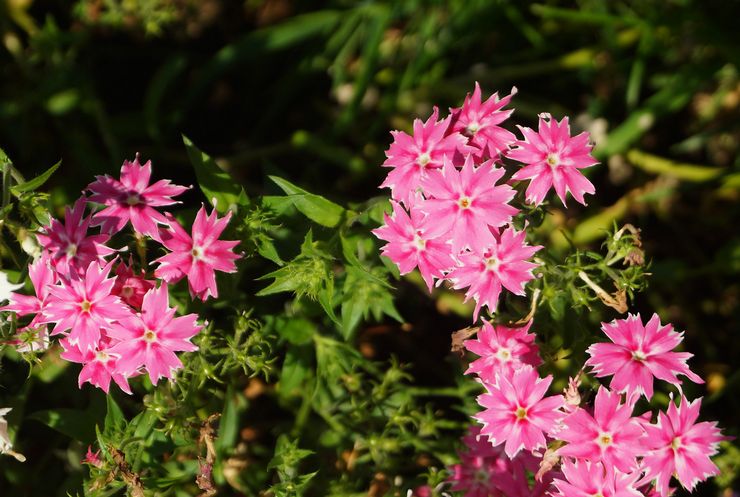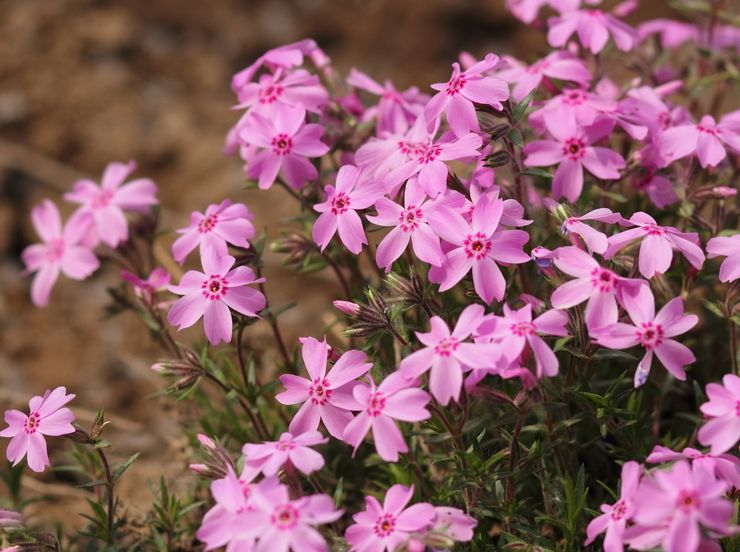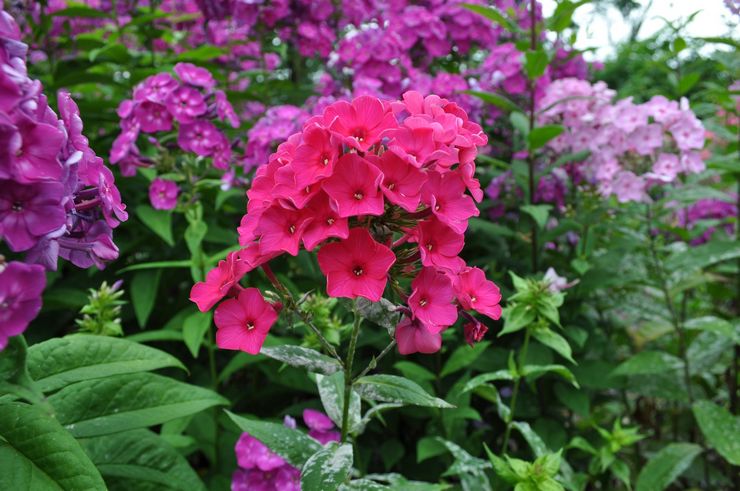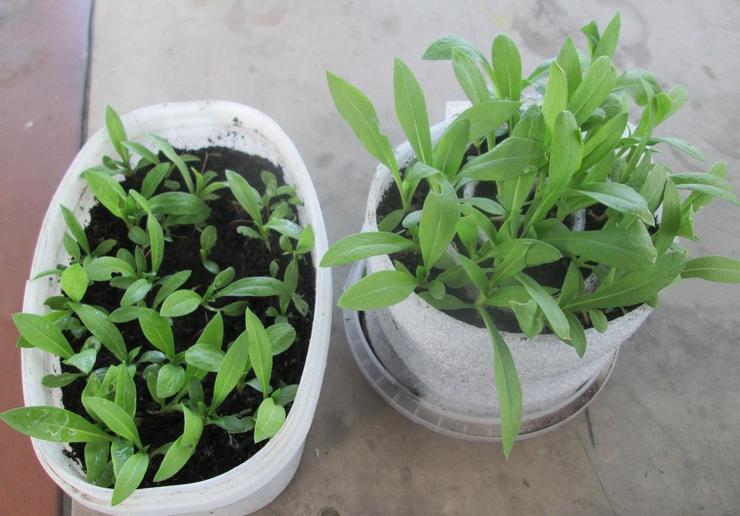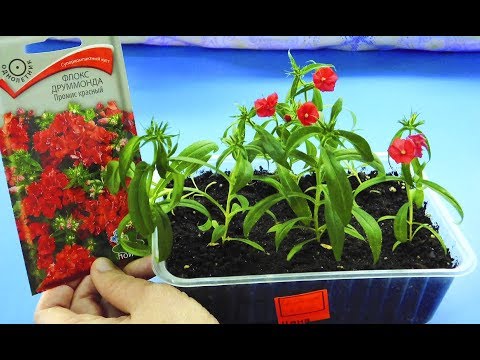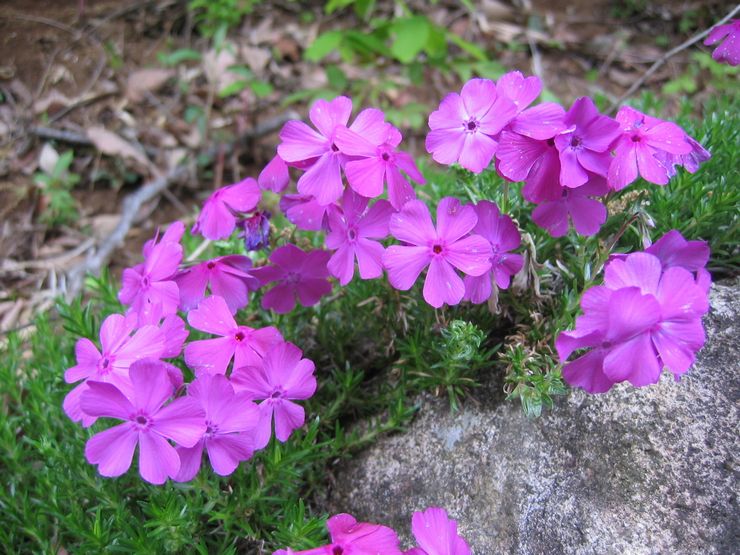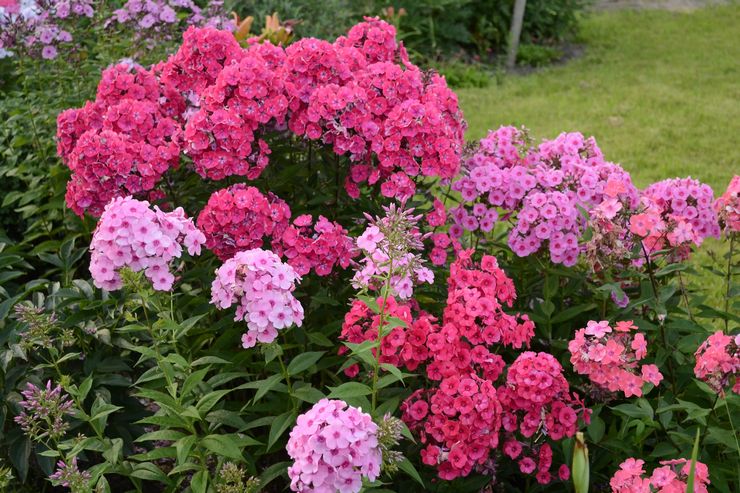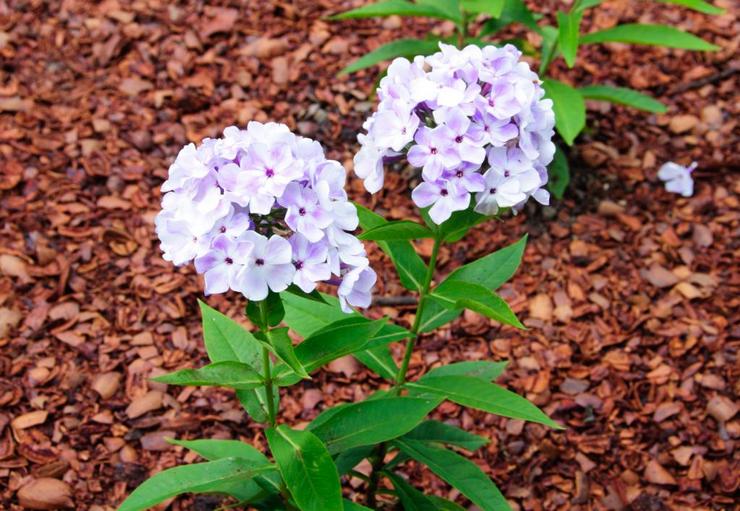Phlox (Phlox) is a spectacular herb, a representative of the Sinyukhov family. Its genus unites about 70 different species, more than half of which are grown as garden flowers. The homeland of a beautiful flower is the North American continent. Phlox began to gain popularity in European gardens from the second half of the 18th century. The name for the plant was invented by the famous Carl Linnaeus. Translated, it means “flame” and refers to the bright color of phlox inflorescences.
There is an interesting legend about the origin of this flower. Sinking into the dungeon where Hades reigned, the sailors of Odysseus held burning torches in their hands. And when they got out of the underworld, they threw unnecessary torches on the ground. And as soon as they touched the ground, they immediately turned into phlox flowers.
Phloxes are appreciated not only for their high decorative effect, pleasant aroma and flowering duration. These plants are very unpretentious to care for and in natural conditions are able to withstand a rather harsh climate. Growing phlox is not a big deal, but it still requires some knowledge..
Description of phlox
The appearance of phlox is strongly influenced by the conditions in which it grows. Because of this, even plants of the same species living in different climatic zones can differ significantly. The unfavorable conditions of the alpine environment turn phlox bushes into miniature and mossy ones. Their height in such places does not exceed 25 cm. In a warm and mild climate, the same plant can form a straight and strong bush that can reach almost two meters in height. Most often, phloxes live in areas with a temperate humid climate and mild, snowless winters. You can usually meet such plants in meadows, near rivers or on forest edges..
There are both herbaceous and semi-shrub varieties of phlox. In addition, plants can be classified according to their flowering time. It can come in spring, summer, and early autumn. At the same time, residents of regions with cold winters are advised to choose varieties with early or summer flowering, and residents of the southern ones, on the contrary, late flowering varieties.
Although most phlox are considered perennials, the popular Drummond phlox is an annual. The same applies to its many varieties..
The most common type of phlox is upright. Their green foliage is elongated. Inflorescences are complex, formed from many (up to 90 pieces) tubular funnel-shaped flowers up to 4 cm in diameter. The size of the inflorescences can reach 30 cm in length. Each flower has 5 petals and 5 stamens, as well as one pistil.
The main types and varieties of phlox
Numerous varieties of phlox differ in color of flowers, shape of leaves and height of stems. Tall varieties are usually tied to a special support so that the stems are not damaged..
Annual phlox
The most famous garden annual is considered Drummond’s phlox. It got its name in honor of the British naturalist and traveler who brought this plant home from American Texas in the 19th century. The beautiful bushes quickly gained popularity among English gardeners. This species blooms from June to autumn frosts. The foliage has a lanceolate-oval shape. The stem is not very thick, but branches well. The size of the bush is quite compact – only up to 30 cm.The flowers exude a pleasant aroma and have a pink, deep red, yellow, lilac or white color.
This type of phlox has two main varieties: large-flowered and star-shaped. The first of them forms bushes up to 30 cm tall. Phlox drummondii mixed has a relatively large flower size and a wide palette of shades, the brightest and most striking of which are red inflorescences. Star phlox can form slightly taller (up to 40 cm) bushes or, on the contrary, more compact (up to 12 cm in total). Phlox drummondii cuspidata features split petals that make each flower look like a small star. In the center of each of them there is usually a peephole..
The various varieties of Drummond phlox are also often classified into two main groups:
- Large-flowered (Tall white, fiery red and bright red)
- Dwarf – plants not exceeding 20 cm (Buttons – two-colored phlox with an eye, Defiance with fiery color, Isabella with yellow flowers, Salmon-colored Salmon, white-flowered Snow Globe and Chamoa with pink inflorescences).
These plants can have both simple flowers and varying degrees of doubleness. Among the latter, the most spectacular are the multi-color mixtures of Promis. There are also tetraploid varieties with especially large flowers and increased resistance to adverse conditions. Among them – Grandiflora and Tetra Riesen.
Phlox perennial
Among perennial phlox species, the earliest flowering is considered subulate. The species owes its name to its narrow foliage. Its flowers appear in late spring – in May. This plant has many branches and blooms very luxuriantly: the bush is almost completely covered with flowers ranging from burgundy to snow-white. Such phloxes are often used for rockeries and alpine slides..
A couple of weeks later it begins to bloom spread out phlox. This is a fairly shade-tolerant plant with sparser, but also larger foliage. Forms small bushes with woody shoots and delicate flowers of blue and lilac shades. Such plants do not give seeds.
At about the same time, it blooms and creeping phlox. Its bushes are only 20 cm high. They are distinguished by many branches and umbrella inflorescences, which have a bright red, pink or purple color. An even more miniature view – phlox Douglas. Due to its tiny size (up to 5 cm), it acts as a ground cover plant, and blooms twice: in late spring and autumn. Small gray-green foliage is set off by small flowers of white, blue, pale lilac or pink.
In the middle of summer, one of the most popular garden species begins to bloom – paniculate phlox. It is distinguished by beautiful green foliage and lush, fragrant buds. Many decorative varieties have been created on the basis of this phlox. Among them:
- Natural Feelings – individual flowers of this variety resemble lilac flowers. They have a variegated color with a predominant lilac-pink tint, against which there are white and green blotches.
- Pure Feelings – double flowers of an unusual multicolored color. Each flower has a slightly twisted shape and is painted white with pale green stripes and cherry blossoms. The height of the bush is average – up to 80 cm.
- The King is one of the most famous varieties, forming one meter high bushes. Flowers up to 4 cm in size can have a variety of colors, most often purple-pink.
- Line Orange (Orange Spat and Orange Perfection) – unpretentious frost-resistant plants, undemanding to care for and possessing bright red-orange flowers that do not lose their rich color even under the scorching sun.
Growing phlox from seeds
In order for phlox to please the eye with their beautiful flowers for as long as possible, the basic rules for their cultivation should be observed. Despite the fact that these plants reproduce well and quickly by vegetative methods (layering, division and cuttings), flower growers often resort to seed propagation. Seeds can be sown almost immediately after they are harvested – before winter, around the end of November. The germination rate of fresh seeds is quite high, but even after just a few months it greatly decreases. If the seeds do not have time to fully ripen before frost, you can dig out the bushes and plant them in pots, keeping them at home until they are fully ripe. Some varieties give ovary only after artificial pollination..
Usually, for such a winter planting, a suitable place is immediately selected. Phloxes will grow on it for several years. Snow is removed from the selected bed and seeds are scattered on the ground, trying to maintain a distance of 5 cm.The crops are covered with a centimeter layer of sifted earth, and then the bed is again covered with snow.
Phlox shoots in this case appear in the spring. When plants form 4 true leaves, they dive, distributing them at a distance of 20-50 cm from each other. At the same time, planting holes are recommended to be prepared in advance: if the plants are planted in spring, a place for them is selected in the fall, for summer or autumn planting, holes are made about 2 weeks before the procedure.
Annual phloxes are usually propagated only by seeds, sowing them on seedlings. This method of sowing helps to protect young plants from spring frosts. In the spring, the seeds are placed in a container, keeping a distance of up to 4 cm. Without filling the crops, they are simply moistened and immediately covered with foil. The container is periodically ventilated and condensation is removed. After emergence, the shelter is removed, usually after about a week..
Phlox seedlings will need bright light, timely watering, and moderate temperatures. 2-3 weeks after sowing, the seedlings dive and for several days after transplanting they are protected from direct sun. During growth, seedlings can be fed a couple of times with a half dose of mineral fertilizers. For better tillering, you can pinch the shoots at the stage of 4-5 true leaves.
&# 127801;&# 127801;&# 127801; SEED FLOXES! GROWING AS EASY AS EASY! How to plant, when to dive and fertilize
Brief rules for growing phlox in the garden
Phlox are unpretentious garden plants, which are distinguished by a wide variety of colors, species and varieties. They are great lovers of moisture, they do not tolerate drought. When choosing a place for planting phlox, you need to choose an area with a slope (so that water does not stagnate in the soil) and in light partial shade. Do not plant phlox under the crowns of large trees and large shrubs..
The flower needs constant and abundant watering, since its roots are located at a depth of about 15 cm and they will immediately feel a lack of moisture. This will affect the growth and development of the plant. Such phloxes have dried leaves and the flowering period is not long. Without sufficient watering, phloxes grow poorly in height and have a minimum number of inflorescences.
During the period of active growth and formation of the plant, support in the form of fertilizing will be required. Usually, feeding is carried out three times per season: before flowering, during and after flowering. As the first fertilizer, a solution with urea is used (2 tablespoons per 10 liters of water), the second is used special flower fertilizers (for example, one spoon of Agricola and two tablespoons of nitrofask), the third is potassium sulfate and superphosphate (1 st .l. of each preparation per 10 l of water).
Phlox reproduce in various ways: by cuttings of a leaf, stem, roots, as well as by dividing the bush and shoots.
Planting and caring for annual phlox
Landing rules
In May-June, after the frost has passed, the plants are transferred to a permanent place. The optimal distance between the bushes is about 20 cm. A small partial shade will be the best corner for them. Despite the unpretentiousness and ability to endure both light frosts and dry periods, phlox do not tolerate overheating of the soil. In shady corners, their flowers retain their decorative effect longer and will certainly not fade, but too deep a shadow will have a bad effect on the abundance of flowering. Planting flowers directly under the crowns of large shrubs and trees with shallow roots is also not worth it – they can become an obstacle to the development of phlox. The cool north side is also not suitable for them. You can select an area with a slight slope, allowing excess water to drain into the lowland, but if the soil there dries up too quickly, it is better to find another place.
Land for planting should be rich in humus, but have sufficient drainage. Heavy, poorly drained soils can ruin plantings. Sandy soils are preferred, in which there is no clay, but it is undesirable to use too light soil – it will dry out and overheat too quickly. It is recommended to dig up loamy lands first, adding sand, peat and the necessary fertilizers there. Lime is applied to too acidic soil.
Before planting, small holes are prepared for seedlings, at the bottom of which compost or wood ash is poured. Phlox does not require too deep digging of the soil – its roots do not lie very deep in the soil and are mainly located at a depth of 15 cm. At the same time, their radius is about 35 cm, so the roots of each bush should be slightly straightened horizontally before being placed in the ground. The rhizome is buried so that its top is at least 5 cm from the ground level. After planting, the soil is slightly compacted, and then watered.
In mixed beds, the planting distance depends on the plants with which phloxes are adjacent. Weakly growing species (bells, cornflower, aquilegia) can be planted closer, and daylilies, peonies and astilbe that require a larger nutritive area, when closely spaced, will quickly deprive the flower bed of its decorative effect. If the flower bed is located in the shade, the distance between the bushes should be slightly increased..
To create the most decorative flower beds, varieties with dark flowers are advised to be planted together with light ones. So they will be able to set off each other and the flower garden will look elegant at any time of the day..
Caring for annual phlox
Annual phloxes do not require much maintenance. Several times a season, the ground around them is carefully loosened, while the adult plants huddle a little – this contributes to the development of roots. Withered flowers should be torn off – they delay the development of unblown buds.
For the growth of phlox, feeding is also important. As the first, you can use diluted manure (25 g per 10 l), this is done at the end of spring. In June, you can repeat the procedure by adding potassium salt to the solution, you can also use superphosphate. By the beginning of July, manure is again introduced in a pure form. The last such top dressing is carried out at the end of July, again introducing a mixture of manure with potassium and phosphorus.
Watering mode
Phloxes are not watered too abundantly, but regularly, trying to do it in the evening or in the morning. 1 sq m usually requires about 20 liters of water. Water is poured directly under the roots, being careful not to use too cold – on hot days, such a contrast can lead to cracking of the stems.
&# 127793; Phlox annuals! Colorful balloons! Growing and care. &# 127793;
Diseases
- Powdery mildew. It is expressed in a whitish matte bloom on phlox leaves. Severely affected plants will have to be destroyed. It is much easier to carry out timely preventive treatments. In autumn, the bushes are treated with a solution of copper sulfate or Bordeaux liquid (both – 1%). In the summer, you need to treat plants with fungicides at least twice. Weak lesions can be tried to be removed by treatment with the same means, sometimes soap is also added to the copper sulfate (250 g of soap and 25 g of sulfate will be required for a bucket of water). In the fall, sick plants can be tried to be rescued by short pruning and re-treatment..
- Variegatedness. In this case, the petals and flowers of the plant acquire an unusual color, damaging the decorative appearance of the entire bush. It is impossible to get rid of such a disease, the affected bushes will also have to be dug up and destroyed..
- Septoria. Dark dots appear on the green part of the plant, growing in size. The bushes and the surrounding area are treated with Bordeaux liquid. The procedure is repeated after a couple of weeks..
- Formos. The stems become more fragile and the foliage begins to dry out. To avoid such a disease, you can periodically treat the bushes with colloidal sulfur. But the solution should not get on the flowers, in addition, processing should be carried out only in warm (from +18) weather.
- Verticillary wilting. He talks about problems with the root system, but he should be feared only if phlox bushes grow in acidic soil.
Pests
A nematode can harm phlox. This tiny worm feeds on plant juices. Usually, its presence can be determined by unhealthy thin shoots, small flowers and deformation of the inflorescences themselves. The affected bushes should be removed, and the soil should be treated with a suitable insecticide, repeating the procedure three times with a three-week break..
Slugs can also attack phlox bushes. They usually eat parts of plants. The best way to deal with them is to regularly weed and loosen the soil near the plantings. You can cope with a large number of such pests by covering the surface of the soil with wood ash, lime or tobacco dust. Large caterpillars can be removed manually from bushes. As a last resort, you can resort to processing from leaf-eating.
Planting and caring for perennial phlox
Planting perennial phlox
Planting of perennial plants is carried out according to the same scheme as in annuals, but still has its own characteristics. After moving the plants to a permanent bed, the soil surface is mulched with humus or dry peat. The distance between plants must be increased to half a meter – over the years of life, the bushes can grow significantly.
Phlox belongs to the few perennials that can be transplanted even during the flowering period, it is enough just to keep a clod of earth intact. But if such phloxes were purchased in the fall in the form of seedlings, you should not immediately plant them in the ground – the plants will not have time to root properly and will not be able to overwinter. This is done only if there is a secluded place for the plants, protected from strong winds and abundantly covered with snow in winter. As additional protection, you can cover the bushes with fallen leaves or peat.
When buying phlox, you should give preference to plants in containers. They allow better preservation of plant roots. But foreign varieties are most often not decorative, they adapt to the new climate longer and reach their peak development only by the 3rd year of life. Packaged seedlings often dry out, such plants will have to be taken care of more intensively, and they usually reach their maximum flowering after 4 years. The best planting material, as a rule, is considered to be own phlox grown from cuttings. They will be able to please with beautiful flowers in the second year of existence..
In autumn, procedures for dividing adult plants that have lost their attractiveness are also carried out. This can be done in late August or early September. As the rhizome grows, the central part dries out very first, so it is cut off, using only lateral divisions for reproduction. The resulting plants should have several large stems, foliage and growth buds, as well as roots, of which too long can be shortened before planting. They try not to clear the soil of the Delenka if possible, but to hold the roots in a damp cloth before planting. The aerial part of the plant at the time of transplantation can also be wrapped with a non-woven material soaked in water. Before frost, plants should be taken, but such actions to rejuvenate plantings can be carried out in the spring, and sometimes even in summer.
In the fall, you can also plant phlox cuttings rooted in the spring. For autumn planting, compost must be added to the soil. If necessary, the composition of the soil is adjusted by adding sand to the clay soil, and peat to the too sandy soil. Plants are lowered into prepared shallow holes and their roots are spread. In dry weather, the seedlings are watered at intervals of a couple of days for at least two weeks. One bush will require about 2 liters of water. When the earth dries up, it is loosened a little and covered with a layer of mulch up to 4 cm thick.
Perennial phlox care
The general rules for caring for such phlox do not differ from caring for annuals, but you will have to feed such bushes a little more often. The last fertilization period is during seed setting. As a top dressing, a solution of superphosphate and potassium sulfate is used (for 5 liters of water, 10 and 5 g, respectively). Top dressing is carried out in the evening, trying to prevent the composition from getting on the leaves. With proper care, perennial bushes can grow in one place for about 7 years, although already at 4-5 years they begin to require rejuvenation. Overgrowing plantings can lose their appearance, and their flowering gradually weakens.
During the entire growth period, such plants can be propagated vegetatively. It is permissible to cut phlox cuttings when its stem grows to 5 cm. This can be done until the end of September, but spring or summer cuttings that have not had time to stiffen are best taken. Green stems with a pair of internodes and several pairs of leaves are suitable as planting material. To prevent the foliage from withering, it is recommended to keep them in a container of water for about an hour (but no more) before planting. A bed with arches covered with a film is best suited for this..
Before planting, the lower leaves should be removed, and the rest should be shortened by about half. To make the cuttings take root faster, you can cover the top of the soil with sand up to 3 cm thick. Cuttings are planted at about the same (or slightly less) depth. After watering, they are shaded. Rooting should take place in a month, after which the plants can be transplanted to their final location. For propagation, you can use not stem, but root cuttings. Usually, the rhizomes of the dug bushes are used for these purposes. They are divided into pieces about 7 cm long and planted in the ground. A year later, a flowering phlox bush will appear in this place..
To obtain layering, before the end of flowering, the phlox shoot is bent to the ground, fixed in several places and spud with a peat-humus mixture. In autumn, a new plant is separated from an old bush and planted in a chosen place..
The secret to caring for perennial phloxes to keep them lush
End of flowering and wintering period
Sometimes annual phlox species can successfully endure the winter, but they will bloom much worse in the second year. Usually in the fall, seeds are simply removed from such plants, the bushes themselves are removed, and then they thoroughly dig up the garden.
Wintering of perennial phloxes largely depends on the abundance of snow cover. Being under a half-meter snowdrift, phloxes calmly tolerate frosts down to -30 degrees, but without proper shelter, their kidneys will begin to freeze even in light frosts down to -15 degrees. Stronger frosts can destroy the roots of plants themselves. In order not to rely on the weather, it is recommended to cover the flowers yourself. The dried overground part of the plants is cut off, and the rhizomes are covered with a mixture of earth and peat. From above, the garden bed is covered with dry foliage, spruce branches or bunches of straw.

